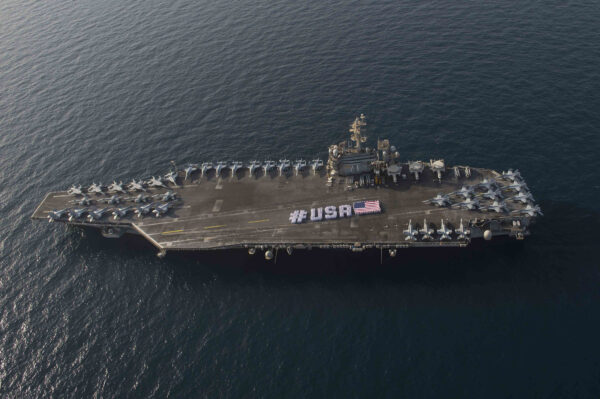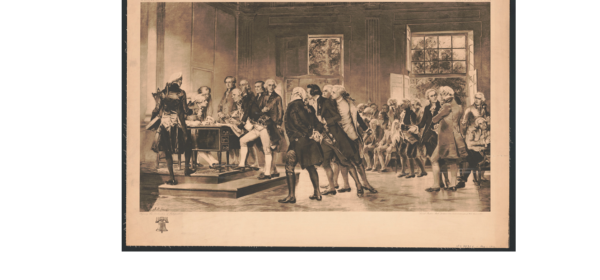
Sailors of the USS Theodore Roosevelt, normally stationed in San Diego, celebrate the Fourth of July while on deployment in 2015. (Photo: U.S. Navy)
Independence Day marks the anniversary of the signing of the Declaration of Independence, voicing the 13 American Colonies’ desire to secede from British rule during the American Revolutionary War.
Prelude to July 4, 1776
Most American colonists celebrated their European heritage through the early 1700s. But constant warfare among European powers and a growing cultural identity among the 13 colonies would lead to a sense of detachment from the Old World for many. This culminated in the time following the Seven Years’ War. As Britain levied increasingly severe taxes on the colonies to avert an economic crisis within its own borders, resentment among colonists reached a boiling point — and sympathy for a rebellion grew exponentially among ordinary Americans.
Still, the desire for armed conflict was largely considered a radical idea even during the first few months of the American Revolutionary War. This would change, however, as British oppression escalated in response to the actions of the first American rebels. Public sentiment swayed, and the Second Continental Congress formally expressed its intent to create a new nation.
April 19, 1775: The Battles of Lexington and Concord Spark the American Revolution
The Battles of Lexington and Concord ignited a revolution that had been kindling as early as 1763. The twin skirmishes ignited public fervor for the colonial militias and their rebel cause. Within two months, Congress established the Continental Army and open hostilities engulfed the colonies.
Early 1776: The American Public Begins to Favor Independence Over Improved Standing in British Parliament
At the start of the war, most colonists favored increased standing in the British Parliament over independence. However, a string of minor American victories, British employment of Hessian mercenaries — which many colonists saw as involving outsiders — foreign support and recognition, and popular texts such as Thomas Paine’s Common Sense emboldened recruitment for the Continental Army, gradually shifting colonial public opinion in favor of independence.
By early 1776, British loyalists in colonial governments had largely fled their offices, allowing revolutionaries to seize control of all 13 American colonies. In only a few months’ time, independence had gone from a fringe belief to dominating the colonial conscience.
July 2–4, 1776: The Declaration of Independence
Congress officially voted in favor of seceding from Great Britain on July 2, and two days later, the U.S. Declaration of Independence was signed. The United States of America was born. The war, however, would not be so swift.

The signing of the U.S. Declaration of Independence on July 4, 1776. (Photo: U.S. Library of Congress)
The American Revolution: victory after victory for the British Military only leads to a stunning defeat
The early years of the American Revolution would juxtapose minor victories with catastrophic defeats. American forces were undersupplied, underfunded, moderately trained at best, and often suffered low morale. Most of the fighting was centered in the northern colonies for the first few years of the war, and victories were sparse.
It wouldn’t be until General George Washington drove his forces south that the war would begin to turn in favor of the Americans. Continental war planners knew they only needed to outlast the British Military, which at the time, was widely regarded as the most powerful in the world. By expanding the front, the British would be forced to spread reinforcements and supplies that would often take months to arrive from Europe.
Despite Britain’s battlefield success through much of the war, the most decisive victory would instead be handed to Washington’s forces at the Battle of Yorktown roughly five years after the signing of the Declaration of Independence. Through a combination of outmaneuvering and intelligence gathering, Britain’s top military commander was forced to surrender when Washington was able to surround the bulk of the British Army by land — and the arrival of the French Navy cut off Britain’s intended escape by sea.
Though the revolution would not officially end for another two years, the Battle of Yorktown proved to be the most decisive of the war. Britain would not mount another successful campaign in the United States until the War of 1812, decades later.
Legacy of Independence Day
The signing of the Declaration of Independence had two major consequences. First, it cemented the purpose of the Revolutionary War: to secede from Great Britain and establish the right to self-determination. Second, it set the stage for garnering allied support from the other European powers.
Shortly after the declaration was signed, copies were sent to the foreign press to elicit support from the other European powers of the time. The move worked, attracting both open support from France and covert support from the Dutch Republic and Spain — relationships that ultimately proved instrumental in an American victory years later.
Since the end of the war, the Fourth of July has been celebrated as Independence Day, feeding a growing sense of unity among the American colonies — now states — that would not be tested for almost a hundred years.
To learn about more U.S. Military and veterans holidays, click here.













